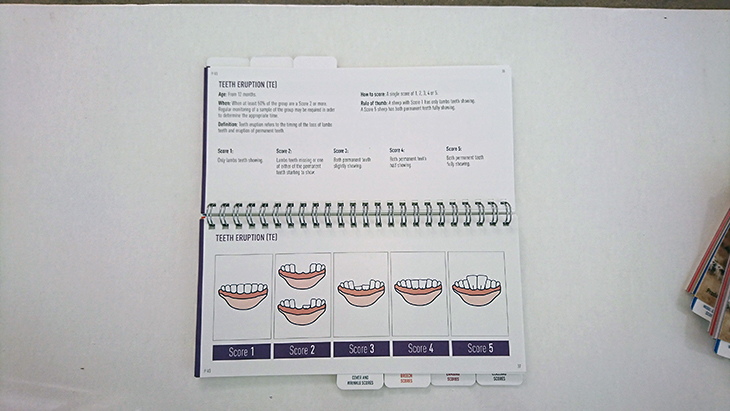The new Producer Version of the Visual Sheep Scores booklet.
An updated Producer Version of the Visual Sheep Scores (VSS) booklet is now available. VSS is a pocket guide for commercial and stud breeders, providing a standardised framework for assessing and scoring visual sheep traits.
UPDATES IN THE LATEST VERSION INCLUDE:
- improvements to the usability of the booklet
- inclusion of scores for Teeth Eruption (TE) and Horn (HORN)
- allowance for both undershot and overshot jaw scores
- inclusion of scores for the new lambing traits Maternal Behaviour (MB) and Lambing Ease (LE)
- further clarifications to trait definitions and scoring diagrams.
The Visual Sheep Scores (VSS) booklet has been redeveloped after receiving industry feedback which was incorporated into an extensive review process. Sheep classers along with commercial and stud breeders across the industry were involved. Recent experience with Merino Sire Evaluation and the Merino Lifetime Productivity (MLP) project was also considered in the review. The Research Version is now being updated to include the changes made to the Producer Version.
The review of the Producer Version included clarifications to trait descriptions and diagrams to bring them up to date with industry requirements, along with the consideration of a number of new traits. Some new traits were included in this version and others will require further development as additional research is completed.
The result is a set of current and applicable scores of fresh descriptions and diagrams all presented in a user-friendly booklet, with sections now separated with a tab for easy look-up. New scores are outlined for the now- included visual traits: Teeth Eruption (TE), Horn (HORN) and lambing scores for Maternal Behaviour (MB) and Lambing Ease (LE). Classing grades have also been further defined into Overall Selection Grade (SGRADE) and Classer's Visual Grade (GRADE).

An excerpt from the updated Visual Sheep Scores booklet, displaying the newly included Teeth Eruption (TE) trait page.
A standardised scoring framework enables visual assessment results to be compared between sites and locations, as well as across industry. Commercial and stud breeders can use the Visual Sheep Scores as a selection tool in their own operations by focusing on selecting traits that have commercial value for their operation. However, it is important to maintain a selection balance and be mindful of all the traits that determine profitability and quality in the flock.
VSS is extensively used by members of MERINOSELECT, DOHNE and LAMBPLAN to score a range of traits. It is also used for Merino Sire Evaluation classing for a wide range of visual assessments completed under the Australian Merino Sire Evaluation Association (AMSEA) banner and is also used by classers at each of the five MLP project sites and for MLA's Genomic Resource Flock. Classing activities include scoring wool quality, conformation, breech cover and wrinkle, plus pigmentation assessments.
Updates will be used in 2020 classing activities at AMSEA and MLP sites, with the collected data then able to be submitted to the Sheep Genetics MERINOSELECT database as visual score data and genetic information. This is then used to progress development of Australian Sheep Breeding Values (ASBVs). Developed by Sheep Genetics, ASBVs enable ram breeders and commercial sheep producers to compare the genetic potential of rams and ewes for a range of production traits, independent of the environment and location.
VSS was first developed by AWI and MLA in 2007 to be used across the sheep industry by stud and commercial sheep breeders by providing a standard set of scores to assess the phenotypic or visual sheep traits. The review in 2012 has now been superseded by this 2019 update.






